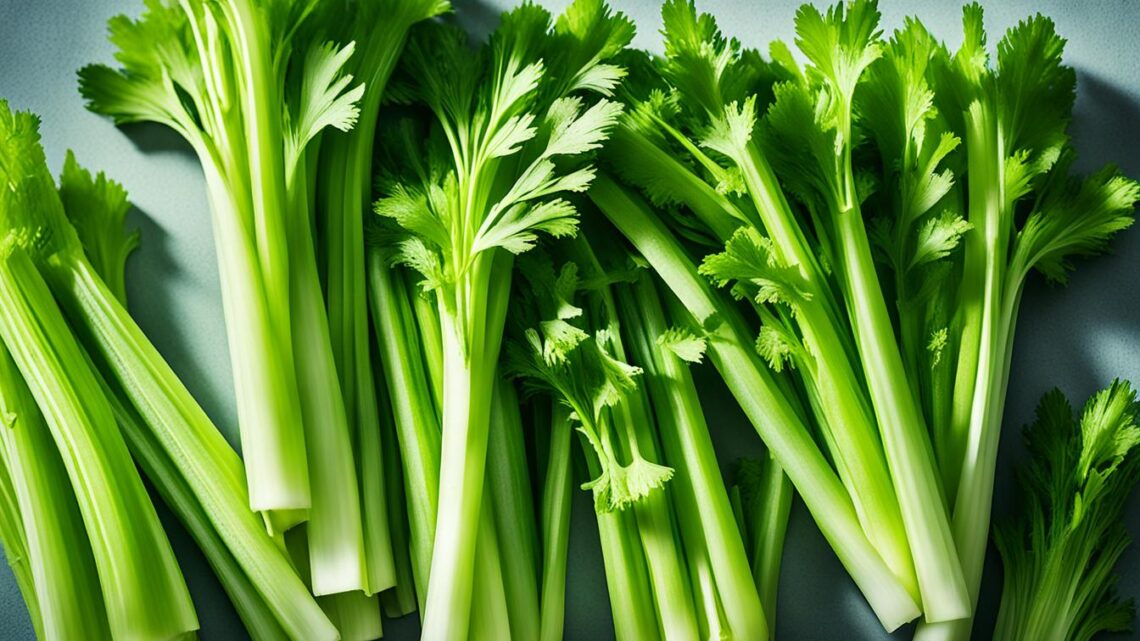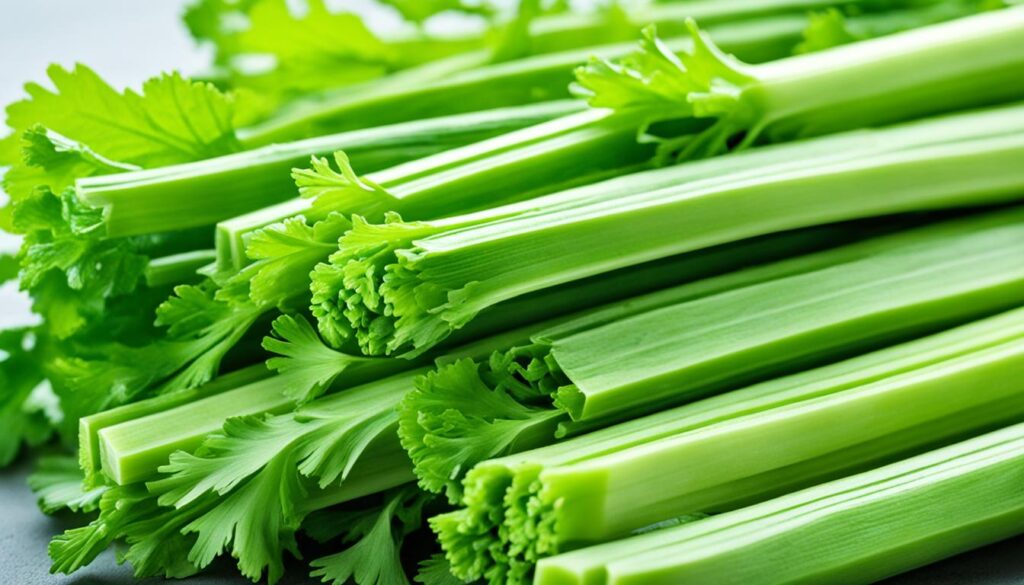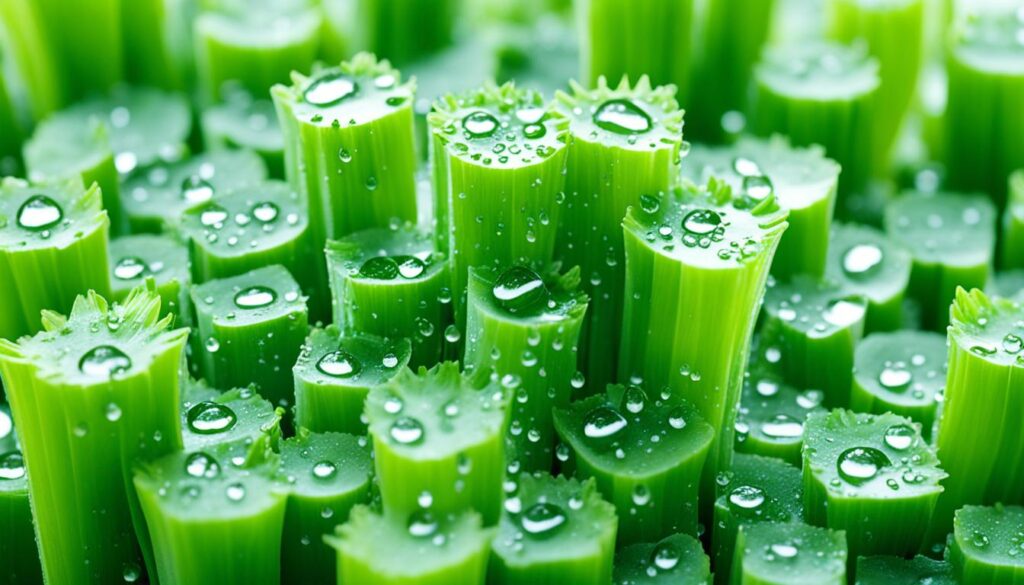
Have you ever thought about why celery is a superfood? This humble vegetable is packed with nutrients and is very versatile. It’s a key ingredient in many kitchens. Let’s discover why celery is so good for you and how it can make your food taste great.
Celery comes from the Mediterranean and is loved by health lovers and foodies. It’s crunchy and tasty. Let’s see how celery can change your meals and help you feel better.
What is Celery?
Origins and Background
Celery is a tasty vegetable that comes from the Apiaceae family. This family also includes carrots, parsnip, fennel, parsley, and cumin. It has a long history, starting in the Mediterranean and Middle East. People have used it as food and medicine for hundreds of years.
Celery is loved for its special taste and crunchy texture. It’s a key ingredient in many dishes, like soups, salads, and sandwiches. At first, people grew celery for its leaves and seeds, not its stalks. These were used for medicine.
Now, thanks to breeding and farming, we have the celery stalks we enjoy today. From ancient times to now, celery has always been popular and useful.

Celery’s history and uses make it interesting and important. Learning about its origins helps us see its value in food and medicine. It shows how celery improves our lives in many ways.
Nutritional Profile of Celery
Celery is a super nutritious vegetable. It has lots of water and is very low in calories. A 1-cup serving of chopped celery has only 14 calories.
It also has 0.7 grams of protein, 0.2 grams of fat, and 3 grams of carbohydrates, with 1.6 grams of fiber.
Celery is full of vitamins and minerals too. A medium stalk gives you 30 micrograms of vitamin K, which is about 10% of the daily need. It also has 263 milligrams of potassium, iron, zinc, and other important nutrients.
Mostly made of 95% water, celery is very hydrating. Its water, fiber, and nutrients make it great for health.
Celery also has many antioxidants. These include caffeic acid, p-coumaric acid, ferulic acid, apigenin, luteolin, tannin, saponin, and kaempferol. These help protect the body from harm and lower the risk of chronic diseases.

Celery is not just good to eat. It’s also used in many recipes, like soups and salads. Plus, it has been used as a medicine for a long time, showing its amazing health benefits.
Health Benefits of Celery
Celery is a versatile and nutritious vegetable. It offers many health benefits. It’s packed with antioxidants, making it great for your health.
Cancer Prevention
Celery has compounds like flavonoids and vitamin C. These act as antioxidants. They help fight free radicals and may prevent cancer, like pancreatic and breast cancer.
Blood Pressure Management
Celery has a compound called phthalide. It relaxes blood vessel muscles, improving blood flow and lowering blood pressure. Its potassium also helps balance sodium, keeping blood pressure healthy.
| Nutrient | Amount per 80g Serving |
|---|---|
| Vitamin C | 5mg |
| Vitamin K | 30μg |
| Potassium | 256mg |
| Dietary Fiber | 1.2g |
Celery is low in calories but high in water and fiber. It’s great for a balanced diet. Enjoy it raw, cooked, or juiced for lots of celery health benefits, celery antioxidants, and celery phytochemicals.

Culinary Uses of Celery
Celery is a versatile ingredient used in many dishes. It has a crisp texture and mild flavor. This makes it great for adding crunch and freshness to salads, dips, and smoothies.
It’s also a key part of the mirepoix, a mix used in soups and sauces. This blend is essential for many recipes.
Celery goes well with many flavors. It pairs well with dill, apples, mushrooms, potatoes, and lentils. This makes it useful in both savory and sweet dishes.
It’s used in many recipes, like creamy pasta dishes and hearty soups. Celery adds a refreshing crunch to salads and balances flavors in many dishes.
Celery is often found in Italian sausage & pasta, grilled steak salads, and Bolognese sauce. It’s a versatile ingredient that can improve many dishes.
| Celery Culinary Uses | Percentage of Recipes Featuring Celery |
|---|---|
| Salads and Slaws | 21% |
| Soups and Stews | 12% |
| Pasta and Rice Dishes | 9% |
| Grilled and Roasted Dishes | 9% |
| Garnishes and Cocktails | 6% |
| Stuffings and Dressings | 6% |
| Other Savory Dishes | 37% |
Celery is widely used in cooking for its versatility. It adds crunch and freshness to raw dishes and is a key ingredient in cooked meals. Celery’s unique flavor enhances many ingredients and cuisines.
Celery in Recipes
Appetizers and Snacks
Celery is great in many recipes, from snacks to main dishes. For a quick snack, dip fresh celery in hummus or pimento cheese. Or, fill celery with peanut butter and raisins for a protein-rich snack.
Celery adds crunch to green smoothies, mixing well with fruits and veggies. It’s also perfect for tuna or chicken salad, making other flavors better.
| Recipe | Celery Ingredients | Serving Size | Calories per Serving |
|---|---|---|---|
| Simple Braised Celery | 8 celery stalks | 4 servings | 28 calories |
| Waldorf Slaw | 4 celery sticks | 6 servings | 156 calories |
| Herby Celery & Bulgur Salad | 1 bunch of celery | 4 servings | 262 calories |
Celery is great for snacks, appetizers, or adding to smoothies. Try out different celery recipes, celery appetizers, and celery snacks. You’ll find many ways to enjoy this tasty and healthy veggie.
Growing and Storing Celery
Celery is a great vegetable to grow at home. It’s easy with the right care. Whether you’re new to gardening or have been doing it for years, growing and storing celery can be fun.
To grow celery well, you need soil that drains well and is full of compost or leaves. It likes cool weather, between 65°F and 75°F during the day and 60°F to 65°F at night. Start with celery transplants and keep them 12 inches apart. Celery needs about 1-2 inches of water each week. Drip irrigation is a good way to keep the soil moist.
When you harvest celery, keeping it fresh is important. Choose stalks that are bright and crisp. Store them in the fridge’s crisper drawer in a bag for up to 2 weeks. You can also freeze celery to keep it for even longer.
| Celery Cultivation and Storage | Key Factors |
|---|---|
| Planting |
|
| Harvesting |
|
| Storage |
|
Follow these tips for growing celery, celery cultivation, and storing celery. You’ll enjoy fresh, crisp, and tasty celery from your garden or home. Keeping celery fresh with the right storage lets you enjoy its health benefits all year.
Celery
Celery is more than just its crunchy stalks. It has other parts that can make your meals better. The knobby, ball-like end is called celery root or celeriac. It tastes earthy and can replace potatoes in many dishes.
Celery salt is another part made from celery seeds and salt. It adds a mild, savory taste to food. This seasoning is great for many recipes.
Celery juice is popular for its health benefits. It’s a drink full of vitamins, minerals, and antioxidants. Using celery stalks, roots, salt, or juice can make your meals tasty and healthy.
Celery is versatile in cooking. Try new ways to use it in your recipes. You’ll find many flavors and textures to enjoy.



